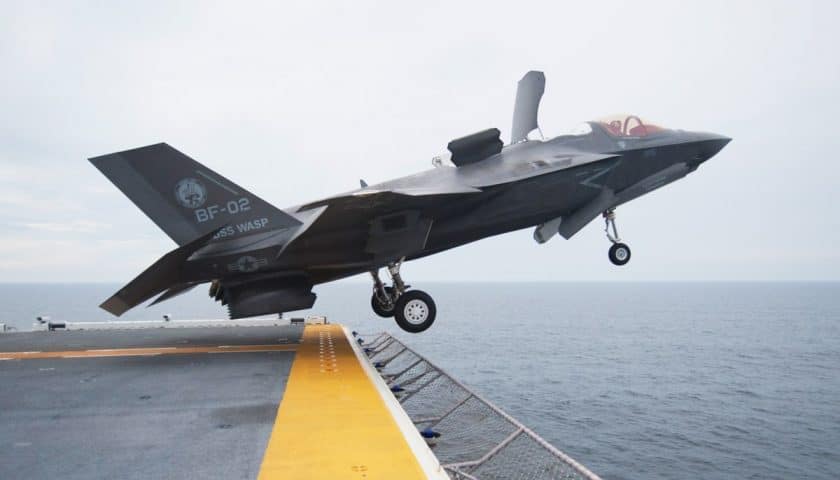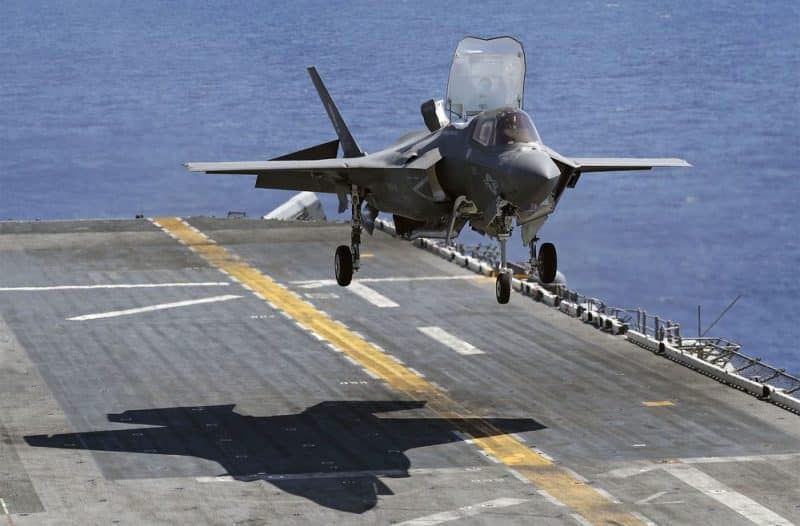On October 3, 2021, following a year-long modernization program, the Japanese Naval Self-Defense Forces assault helicopter carrier Izumo saw for the first time a United States Marine Corps F-35B Lightning II fighter jet taking off from its flight deck (photograph in main illustration), some 76 years after the last plane of the Empire of Japan left the deck of an Imperial Japanese Navy aircraft carrier.
After the United States, Great Britain and Italy, it is the 4th country to operate the American stealth fighter with vertical or short takeoff and landing from Lockheed-Martin from an aircraft carrier, but not the last, since South Korea is preparing an aircraft carrier dedicated to this use, and that Spain is widely expected to also acquire the aircraft in order to replace its Harriers and preserve its naval aviation capacity.
Thanks to its nozzle that can be rotated almost 90°, and a stabilizing fan located behind the cockpit, the F-35B is capable, like the Harrier, of taking off from a springboard, but also from a straight deck of a aircraft carrier while maintaining a significant load thanks to the 180 KN of thrust delivered by its Pratt&Whitney F-135-PW-600 reactor equipped with a lift system specially developed by the British Rolls-Royce, the originator of the famous reactor Pegasus of the Harrier.
And even if the F-35B carries less fuel than versions A implemented from land runways, or C from aircraft carriers equipped with catapults, its short/vertical takeoff and landing limits its maximum takeoff weight , and therefore its capacity to carry ammunition and fuel, and that it struggles to exceed Mach 1, it nevertheless remains a device with unique characteristics to date.
These make it possible to implement a fighter that is on par in many areas with land-based fighters, from aircraft carriers without catapults and stopping points, and therefore much less expensive than aircraft carriers. implemented by the United States and France.

The performance of the F-35B, in particular its stealth and its wide range of sensors and information processing and communication capabilities, make it an aircraft suitable for two missions, namely the support of amphibious assault forces and the air protection of the naval group.
Through its stealth in the frontal sector, the aircraft can, in fact, eliminate opposing anti-aircraft defenses, then provide the necessary fire support to the forces engaged on land, while coordinating naval support thanks to its data fusion.
This same detection and data fusion capacity makes it a valuable asset for protecting the naval group in the absence of a device combining air surveillance aircraft and combat aircraft, even if the American aircraft does not have the reach to carry out air combat missions, or CAP, as is the case with aircraft ensuring the security of French or American aircraft carriers.
Finally, even despite its low speed and lower maneuverability than many modern fighters, the F-35B remains a formidable adversary in air combat, particularly at long range and when operating in a cooperative environment allowing it to benefit to the best of the advantages offered by stealth and data fusion.

75% of this article remains to read,
Subscribe to access it!
The Classic subscriptions provide access to
articles in their full version, and without advertising,
from 6,90 €.
Newsletter subscription
Register for the Meta-Defense Newsletter to receive the
latest fashion articles daily or weekly


[…] he knows he is vulnerable to massive preventive strikes. This is precisely where the F-35B, probably the most successful version of Lockheed-Martin's aircraft, offers capabilities that no other aircraft is able to […]